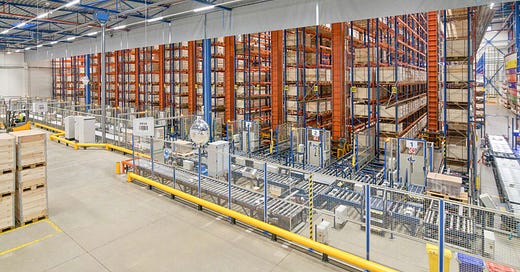Despite our lofty expectations, the defining material of the 21st century so far has probably been cardboard: the consumer-facing surface of a logistically administered world; the last mile made visible and tangible; what we scan for, in box form, on our porches and in our mailrooms and lobbies, hastily gathering it all into our homes as we find it and then ripping each package open in a postmodern daily harvest ritual. Cardboard—unboxed, flattened, bundled, discarded, recirculated—is the disposable but essential outer sheath of the global economy in its physical state.
Cardboard embodies the actual values of our era—not the harmonious perfection of a high modernist sci-fi monolith like the Starship Enterprise or even a humanoid robot (the iPhone may be the maximum scale at which the “future” has delivered this quality to consumers), but instead flexibility, ephemerality, lightness, and modularity, all qualities that enable tiny parts to circulate within sprawling invisible systems. Venkatesh Rao calls this oozification: systems replacing larger building blocks and more rules with smaller building blocks and fewer rules. See also: shipping containers, tents, e-bikes, pallets. Pyramids and cathedrals are the past; a shapeless pile of cardboard boxes is the future. Although most of us find cardboard thoroughly unromantic and mundane, one group deserves credit for recognizing its subtle power: children, who often prefer cardboard boxes to the toys made specifically for them. They seem to get it.
Previous generations’ glittering visions of the future, depicted so vividly in 20th century film, TV, literature, amusement parks, and advertising, largely failed to materialize in ordinary lived experience—at least in terms of appearances. The exceptions have usually been symbolic, such as high-profile starchitecture or the Cybertruck. But much of the visible landscape could still be reasonably described as “40 years ago plus iPhones.” Today, even the most advanced AI technology doesn’t *look* that good (and when it does, it doesn’t work very well). The grimy dystopia of Blade Runner turned out to be more prophetic than most of the picturesque midcentury sci-fi illustrations, which are nonetheless still with us, now signifying the past more than the future—hauntological ruins that call attention to the difference between what we expected and what we got.
THE KARDASHIANS AND LOGISTICS CULTURE
Because the networked and logistically mediated condition of contemporary life doesn’t lend itself to compelling visualization, efforts to interpret it via pop culture have struggled to move past their awkward early stages. The successful attempts have come from unlikely places: Last year, Kelly Pendergrast wrote a great essay about Khloé Kardashian’s pantry, as depicted on Instagram and The Home Edit (a home organizing brand with a spinoff TV show), describing it as a “performance of logistics” in which Kardashian’s domestic storage space assumes qualities that evoke a warehouse or an IKEA store:
“The long side of the room is lined with a floor-to-ceiling grid of rectangular cubbies stretching the entire horizontal expanse like a spreadsheet (no terminating edge is visible in any of the photos; perhaps they go on forever). The shelves are a muted ash color, almost identical to Ikea’s white stained oak veneer finish…Recessed in the underside of each cubby is a fluorescent or LED light strip, which casts a cool daylight glow on the contents of the shelf below.”
Describing the pantry’s organization scheme, she further emphasizes its gridlike aspect:
“Repeated sets of open top wooden boxes, wide-woven square baskets, small lazy susans, and clear canisters with brushed steel or wooden lids are all evenly spaced across the shelves like someone has selected all and hit “distribute horizontally”…Within the vessels (layers within layers) is nestled the food itself, packaged goods on the bottom shelves and decanted bulk items above. The theme is multiples, the theme is repetition.”
One of the strongest motifs that emerges from Pendergrast’s description of the Kardashian pantry is the illusion of endlessness, as supported by straight lines, right angles, grids, and repetition. “The implied infinity of the grid organizes space without telling a story about it,” she writes. “Or perhaps it only tells a story about itself.” She mentions Donald Judd’s idea of repetition as a resistance to narrative—one thing after another.
For grids, however, this pretense of emptiness or neutrality can conceal the values they ultimately embody. Grids standardize space and make it tractable, effectively overwriting whatever was there before. The urban street grid perhaps illustrates this best, dividing cities into blocks that are relatively homogenous and better suited for market exchange. “The grid is the ultimate platform for modern economic activity,” Pendergrast writes. The grid, of course, is echoed in other “logistical rectangles”—shipping containers and the aforementioned cardboard box. Imposing this rectangular logic on one’s home, then, is a way of getting it under control.




